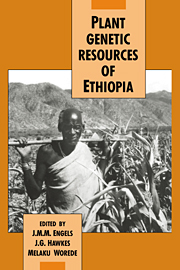Book contents
- Frontmatter
- Contents
- Contributors
- List of acronyms
- Preface
- Part I General introduction
- Part II The Ethiopian centre of diversity
- Part III Germplasm collection and conservation in Ethiopia
- 13 Theory and practice of collecting germplasm in a centre of diversity
- 14 A decade of germplasm exploration and collecting activities by the Plant Genetic Resources Centre/Ethiopia
- 15 Collection of Ethiopian forage germplasm at the International Livestock Centre for Africa
- 16 Germplasm conservation at PGRC/E
- 17 Documentation at PGRC/E
- Part IV Evaluation and utilization of Ethiopian genetic resources
- Index
17 - Documentation at PGRC/E
Published online by Cambridge University Press: 30 October 2009
- Frontmatter
- Contents
- Contributors
- List of acronyms
- Preface
- Part I General introduction
- Part II The Ethiopian centre of diversity
- Part III Germplasm collection and conservation in Ethiopia
- 13 Theory and practice of collecting germplasm in a centre of diversity
- 14 A decade of germplasm exploration and collecting activities by the Plant Genetic Resources Centre/Ethiopia
- 15 Collection of Ethiopian forage germplasm at the International Livestock Centre for Africa
- 16 Germplasm conservation at PGRC/E
- 17 Documentation at PGRC/E
- Part IV Evaluation and utilization of Ethiopian genetic resources
- Index
Summary
Introduction
The quantity and complexity of the information acquired by the Plant Genetic Resources Centre/Ethiopia (PGRC/E) through active collecting, donation and repatriation of germplasm require comprehensive and efficient data management systems. Plant genetic resources can only be successfully utilized if detailed and reliable data on each accession are available to genebank users, breeders, research workers and policy makers.
In 1979, a proposal was made to base such a documentation system on edge-punched cards (Engels, 1979) and this manual system was used until 1982, by which time the amount of data had reached such proportions that the system was overcharged and it became necessary to computerize the documentation activities (Engels, 1985).
At present the documentation system at PGRC/E is based on electronic data processing technology and this has greatly facilitated the handling of the enormous amount of data currently being generated at the centre.
Information sources and descriptor development
The major sources of information in PGRC/E are:
– exploration and collection;
– germplasm introduction and accessioning;
– temporary storage (at +4°C and 30–40 per cent RH);
– field genebanks;
– multiplication and rejuvenation;
– characterization and preliminary evaluation (in field and laboratory);
– seed processing;
– seed testing;
– seed storage (base and active collection at –10 °C);
– germplasm flow;
– further evaluation;
– utilization;
– miscellaneous activities.
Further details are presented in Table 1 and can also be found elsewhere in this volume (Chapters 14, 16, 19).
- Type
- Chapter
- Information
- Plant Genetic Resources of Ethiopia , pp. 235 - 244Publisher: Cambridge University PressPrint publication year: 1991



